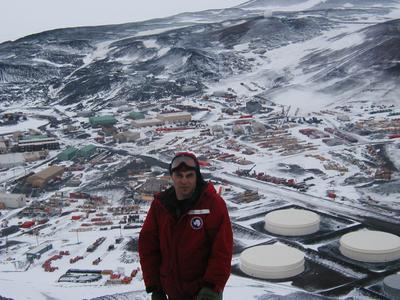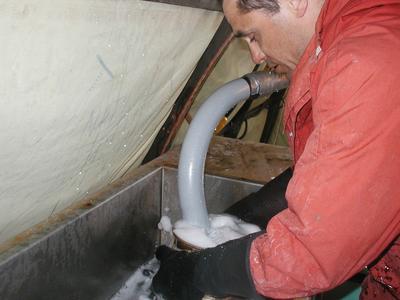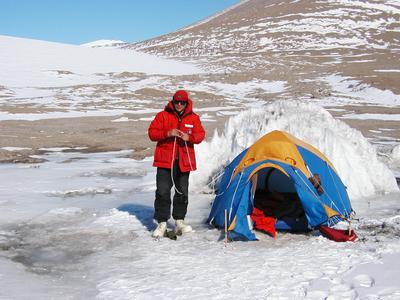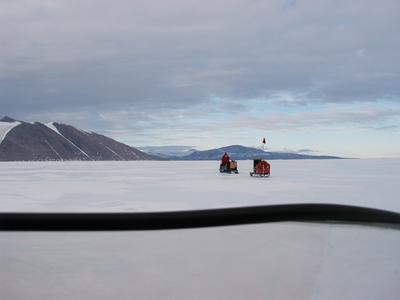
|
|
19 December, 2001

Dr. Sergei Korsun, a member of Dr. Bowser's research project this season, is a research scientist at St. Petersburg University in Russia. His work as a graduate student in invertebrate zoology led him to marine biology with a focus on foraminifera (forams). Upon graduation from the university, Dr. Korsun moved to the Kola Peninsula in the Arctic regions (western part of Russia near the Norwegian border) to continue his study on forams. By spending 14 years in the Arctic researching foraminifera, Dr. Korsun can make comparisons between the Antarctic and Arctic forams.

Dr. Korsun studies the distribution of forams, which is affected by the ecology. While in Antarctica one focus of his research will be to study how the glacier melt water will affect the forams living in Explorers Cove during the seasonal change. (October- February; beginning of spring to late summer). He said that scientists gain a better understanding of global climate on a long-term scale by knowing the factors controlling modern distribution. Why are Astrammina rara abundant in Explorers Cove? What are the factors that allow these one-celled organisms to thrive in this area? Explorers Cove is one of the few places on Earth where Astrammina rara can be found in abundance. Will the seasonal dynamics change the distribution of forams living in the area? Will the water chemistry: salinity (saltiness), water currents, water temperature, or dissolved minerals and nutrients in the water make a difference from one season to the next? Will the fresh water coming in from the glacier melt water affect what is living in the area? Questions lead scientists to search for answers, and many answers may not be found until data has been collected over time. It is by looking at the past and comparing it to the present that scientists may predict what may happen in the future.

Dr. Korsun is using an airlift at Explorers Cove to collect forams through a sieve in the top one-centimeter of sediment from the bottom of the sea floor. When Dr. Korsun was in the Arctic this past summer with Dr. Bowser and Dr. Pawlowski, they traveled on board a ship that took sediment cores from places in the sea where sedimentation rate was high. Dr. Korsun said that by reconstructing and applying modern knowledge and information to the paleo (past) climate, scientists might better understand today's warming trend. Is it part of a natural cycle, human driven, or is it just a chance occurrence? Foraminifera, as well as carbon dating, help scientists determine the time period when the sediment was laid down. By studying the sediment at different depths and time periods, scientists get a better picture of the past climate and whether oscillating temperatures as seen from the past are representative of a natural cycle similar to present day warming. The climate and ecological conditions play a major role in determining what will survive in certain environments.

Dr. Korsun is at our remote camp at the Herbertson Glacier area. Our team was doing a drill/melt to make a new dive hole in this area in order to make a comparison to Explorers Cove. Dr. Korsun also looks at species composition to see which species is dominant in the area and why. He stated that different species of forams prefer different ecological conditions. When our team did a comparison at two nearby places, they both had similar species, but neither had many Astrammina rara , which is dominant in Explorers Cove. While at Explorers Cove, Dr. Korsun's study will also compare the seasonal dynamics of the algal production between October and February. In Explorers Cove, the algae started close to the tidal flat (moat area), where it can be flushed into the sea and suspended in the water. By January, the algal bloom should be in the upper part of the water column. Will this make a difference? Dr. Korsun would like to find out if forams thrive on the short-term algal bloom, and whether the biomass will increase? He would also like to specify or target which species feed on the bloom, as well as determine if the Wales Stream will have any effect on the foram population. Dr. Korsun, along with other scientists on this project will use a CTD (an instrument to check conductivity, temperature, and depth) to measure whether the water column is changing as the season goes from winter to summer state. (To learn more about a CTD, refer back to the December 16 journal entry).

It takes a lot of hard work to get to the science. Dr. Korsun is working with Phil Forte to clear and groom the new dive hole at the Herbertson Glacier area. This one project involved time gathering and setting up equipment and supplies, as well as the actual 36 hours to drill/melt the new dive hole. (See journal entry: November 25). All fuel, equipment, and supplies have to be taken to and from this site (90 minutes from our field camp) by ATV (All-Terrain Vehicle) or snowmobiles. When the dive hole is prepared, the divers will descend through 12-feet of ice to collect the specimens. Then the specimens are prepared for further analysis in a lab setting.

Upon completion of the drill/melt process at the Herbertson Glacier area, Dr. Korsun and I went back to retrieve the melter with the broken runner. (The harsh cold conditions cause extra stress to equipment in Antarctica, so things break down or need new parts when least expected). Dr. Korsun devised a way to bring the melter safely back without adding helicopter hours to Dr. Bowser's project, otherwise the melter would have had to be airlifted to camp by helicopter. (Each project is only allowed so many helicopter hours per season, so this was beneficial and greatly appreciated!) We left camp at 8:00 p.m and returned to our field camp around 2 a.m. (See journal entry: December 2). Everything in Antarctica seems to take more time and effort due to the cold and the remoteness of the continent. Many times, scientists and the people living in Antarctica must figure a new way or solution to solve a problem. This was only one more example of seeing the human spirit at work. (I learned a lot from Dr. Korsun in this respect.) Although, we were tired, cold, and hungry, Dr. Korsun used all available resources to bring the melter back It's important for students to see that applying knowledge and skills to find a solution is one of the best possible resources. Heading out across the waves of sea ice with a hand-held radio and two snowmobiles made me feel like I was but a speck of dust on this planet. I was filled with awe as we passed the massive grounded icebergs, the glaciers, Mt. Erebus (the southern-most active volcano in the world), and the Weddell seals out on the ice. I came to Antarctica to bring science to students, yet along with the science, I find that I'm taking away a greater appreciation for the hard work, effort, and "thinking beyond the box" that scientists put into their research. Dr. Korsun, along with the other scientists on Dr. Bowser's project, have added a lot to my own learning. In doing so, they will always be a part of my teaching.
Contact the TEA in the field at
.
If you cannot connect through your browser, copy the
TEA's e-mail address in the "To:" line of
your favorite e-mail package.
|
